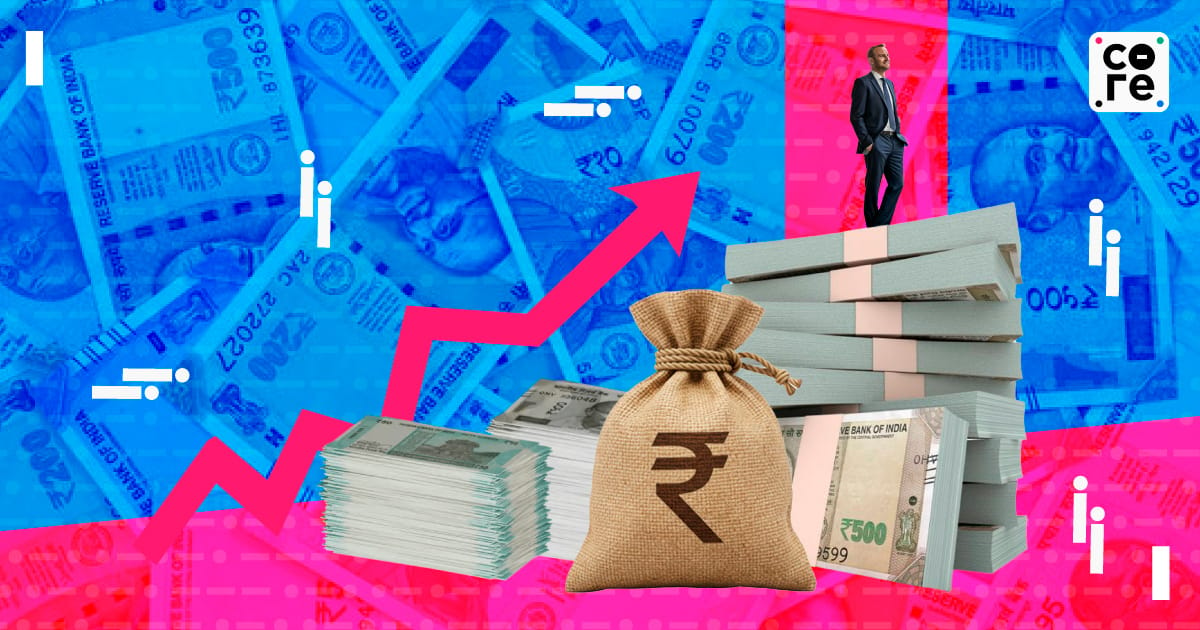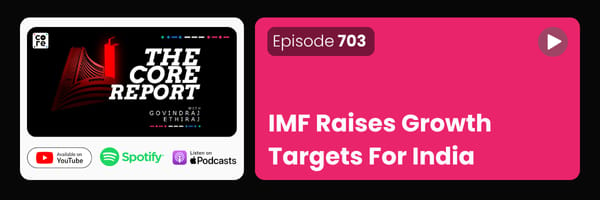- The Core
- Posts
- Cracking Ultra-Wealth India
Cracking Ultra-Wealth India
Good Morning. India’s rising markets have made many rich. Affluent and high net worth households have grown at a rapid pace, riding real estate, gold, and stockmarket highs. Yet, as the Mercedes-Benz Hurun report found, only a handful turned that into enduring wealth. The lesson is this: just growing assets isn’t enough to make it to the next step of the wealth pyramid.
Indian equity indices fell for a second straight session with the BSE Sensex closing at 82,029.98, falling 297.07 points or 0.36%. The NSE Nifty50 closed at 25,145.5, falling 81.85 points or 0.32%.
In other news, LG Electronics sees a great first day of trading. Meanwhile, blockchain could put an end to fraudsters faking your consumer goods.
DECODE THE NEWS
Getting Rich in India Is Easy — Becoming Ultra-Rich Takes Smarts, Not Assets
What?
India is producing millionaires at a record pace. But those who make the journey from being rich to ultra rich are a much smaller club. To qualify as an HNI or high-networth individual, one needs to have $1-1.2 million. But the keys to the real vault - with wealth of over $12 million - defined as an ultra high-networth or UHNI individual doesn't come easy.
Mercedes-Benz Hurun India Wealth Report 2025 found that during the golden era of wealth creation (2017-25), the number of affluent Indian households grew 445% to 8.7 lakh. Similarly, HNI households grew 202% to 5.9 lakh. But only 5% crossed into UHNIs, and a mere 0.01% became billionaires.
India’s millionaire class is ballooning, but breaking into the ultra-rich league still demands more than inherited assets or market luck — it takes sharp entrepreneurial bets and high-conviction investing. As wealth creation enters a new phase, the truly affluent are those turning from passive holders to active builders of businesses and capital.
Why?
From 2021 to 2025, the Nifty50 rose from 14,700 to nearly 24,000; gold prices hit records; and real estate surged across major metros and other cities.
Such market momentum lifted many into the millionaire ranks. But to create outsized compounding wealth, the game shifts from passive to participatory — from owning assets to building enterprises.
“One of the definitive paths to creating this kind of wealth is definitely entrepreneurship with focus,” Anas Rahman Junaid, founder and chief researcher of Hurun India, told The Core.
He said that only 2% of the Hurun Rich List (wealth over Rs 1,000 crore) were investors.
What are the other ways of growing wealth to climb the wealth ladder?
MESSAGE FROM OUR SPONSOR
Don’t get SaaD. Get Rippling.
Remember when software made business simpler?
Today, the average company runs 100+ apps—each with its own logins, data, and headaches. HR can’t find employee info. IT fights security blind spots. Finance reconciles numbers instead of planning growth.
Our State of Software Sprawl report reveals the true cost of “Software as a Disservice” (SaaD)—and how much time, money, and sanity it’s draining from your teams.
The future of work is unified. Don’t get SaaD. Get Rippling.
BUILD ON BLOCKCHAIN
Fake It, But You Can’t Make It
What?
Every product label comes with a promise and assurance. Your coffee claims to have come from certain high-quality beans, while your rice packet claims to be farm fresh.
But it’s everyone’s experience that most of these labels do not tell the truth.
That's a major flaw in the way existing supply chains are designed. They leave plenty of scope for fraudulent activities.
Just three days ago, authorities in Gujarat busted a factory involved in the large-scale production of counterfeit Colgate and Sensodyne toothpastes and Eno sachets. This raised concerns about the growing spread of fake consumer goods in India.
Prof Nikhil Varma of blockchain platform Algorand calls it the PTA problem — proof, transparency, and automation. It’s the missing link that makes supply chains look smarter than they really are.
What Now?
Fake goods are a big deal for manufacturers as well. To fix this, several companies have turned to blockchain platforms.
Everledger, for example, tracks the journey of diamonds from mines to stores. TextileGenesis, on the other hand, verifies if fashion fibres are really organic or recycled. The same transparency could be replicated for your toothpastes and Eno sachets as well.
But there is one condition: these systems work only if every player follows the rules and agrees to become part of one decentralised system.
This series is brought to you in partnership with Algorand India.
CORE NUMBER
0.13%
That’s how much India’s wholesale inflation rose in September — its lowest level in three months — according to data from the Ministry of Commerce and Industry. The number marks a sharp cooling from 0.52% in August, showing easing price pressures across key sectors.
Origin: The modest uptick was driven by higher prices of food products, textiles, and manufacturing goods, even as food and non-food articles fell 1.38% and 1.06%, respectively. Fuel and power prices stayed mostly flat, dipping 0.14%, while electricity costs climbed 1.20%.
By the Numbers: Manufactured products, which make up the largest chunk of the WPI basket, inched up 0.21% in September. Meanwhile, retail inflation — tracked by the Consumer Price Index — eased to 1.54%, the lowest since June 2017.
FROM THE PERIPHERY
LG’s Explosive IPO.
LG Electronics India’s shares surged about 53% on their market debut, marking the country’s biggest IPO draw since 2008. The listing valued the company at roughly $13 billion, surpassing the market cap of its South Korean parent. The shares of the company closed at Rs 1,683, gaining Rs 543, over the issue price of Rs 1,140.
The Lead: Recent GST cuts boosted investor confidence. The IPO was fully subscribed within hours, attracting bids worth nearly $50 billion amid India’s peak festive spending season. Such IPOs of multinational companies are great for India’s economy and reflect a more permanent stake in the country’s growth story.
Trigger: In contrast, Tata Capital and WeWork saw far weaker demand, with subdued subscription rates and minimal first-day gains. Tata Capital’s stock opened just 1.2% above its issue price and remained flat, highlighting the stark difference in investor response.
Mixed Signals on Mega Deal.
Foxconn clarified that it did not discuss new investments with the Tamil Nadu government, despite the state’s industries minister announcing a Rs 15,000 crore commitment yesterday.
The Backstory: The company said its India representative met officials but made no fresh investment proposals. Tamil Nadu responded that the Rs 15,000 crore figure was not a new deal and that the state is simply announcing it now.
Google Joins the Race!
Google will invest $15 billion over the next five years to build its first AI hub in Visakhapatnam, Andhra Pradesh. The company said that the hub will be its largest AI centre outside the United States.
The Lead: The project includes a 1 gigawatt data centre and a new undersea cable landing station to improve connectivity. Google will work with AdaniConneX and Airtel to build the supporting network. The company said the hub will combine data centre operations, new energy sources, and expanded fibre-optic networks, and will serve users and businesses across India.
The Backstory: The announcement follows similar moves by Microsoft and Amazon, which have invested billions of dollars in building data centres and cloud infrastructure in India in recent months.
PODCASTS
IMF Raises Growth Targets For India
On Episode 703 of The Core Report, financial journalist Govindraj Ethiraj talks to Madan Sabnavis, Chief Economist at Bank of Baroda as well as Vikas Jain, Founder and Chief Investment Officer at Multipl.
IMF raises growth targets for India
LG has blockbuster debut on Indian bourses
Decoding the Nobel Economics Prize through an India lens
How are small equity investors responding to the gold and silver rise?
MESSAGE FROM OUR SPONSOR
Learn how to make AI work for you
AI won’t take your job, but a person using AI might. That’s why 1,000,000+ professionals read The Rundown AI – the free newsletter that keeps you updated on the latest AI news and teaches you how to use it in just 5 minutes a day.
THE TEAM
✍️ Zinal Dedhia, Kudrat Wadhwa | ✂️ Rohini Chatterji | 🎧 Joshua Thomas
🤝 Reach 80k+ CXOs? Partner with us.
✉️ Got questions or feedback? Reach out.
💰 Like The Core? Support us.




